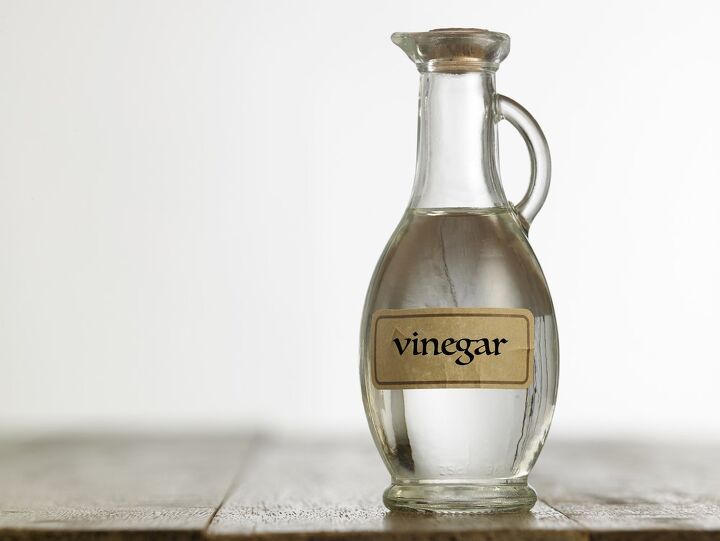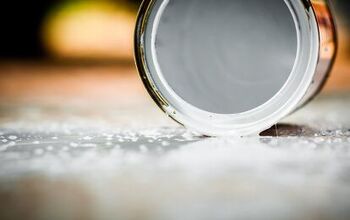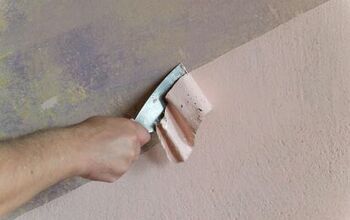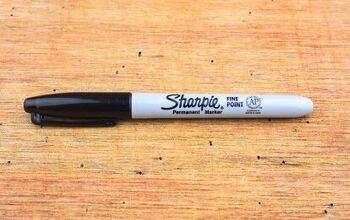Does Vinegar Remove Paint From Wood?

Are you getting ready to repaint a wooden surface in or around your home? Before you can bring your vision to life, you will have to remove the old paint. There are countless ways to remove paint off wooden surfaces, but you’ll be happy to know there may be a very easy, often readily available option. So, the question we’re answering here today is: can you remove old paint from wood with vinegar?
The short answer is yes, vinegar will remove stubborn, old paint from wood. The longer answer is simply applying vinegar to the surface will not dissolve the paint on its own. It will, however, soften the paint and make it much easier to manually remove with a paint scraper and a damp cloth.
In this article, we’re going to briefly go over how to use vinegar to remove paint. More importantly, we’re going to talk about the advantages, the drawbacks, and everything you should avoid during the process. Plus, we’ll talk about other paint removal methods, so you are 100% prepared for the upcoming project.
Do You Need to Hire a Paint Contractor?
Get free, zero-commitment quotes from pro contractors near you.

Using Vinegar to Remove Paint from Wood
The procedure for removing paint with vinegar is very simple, which makes it an ideal DIY solution to a pretty common problem. Even if you’re not the best with home improvement projects, we guarantee you won’t have a problem completing this task. Here’s the quick step-by-step process:
- Heat up a small amount of white distilled vinegar in the stove or microwave.
- Soak a paintbrush or cloth in the hot vinegar and dab the vinegar on the wood.
- Let it sit for 10-20 minutes. Apply more hot vinegar if the paint hasn’t softened yet.
- Use a paint scraper to remove the loosened paint.
- Wipe down the entire surface with a damp cloth to clean off the vinegar and any other traces of paint.
The Benefits
White vinegar stands out as one of the best paint removal tools for wood for many reasons. For starters, it is affordable and easy to use. Vinegar is a staple in most kitchens and can be used for countless tasks in and around your home.
On top of being readily available, vinegar is one of the most eco-friendly paint removal materials you can use. Since it doesn’t contain harmful chemicals or release fumes into the air, you won’t have to worry about negatively impacting the planet or hurting yourself by breathing it in.
The Downsides
There aren’t many disadvantages for using vinegar to get old paint off wood, but there are a couple of things to consider. When compared to some paint strippers and chemical or heat treatments, using vinegar will take longer and require a bit more work on your end.
To begin, you will have to heat the vinegar, wait for it to do its magic, reapply if the paint is still stuck. Once it has loosened, you will then have to manually remove the paint with a scraper and a damp cloth to get all traces of paint and vinegar off the surface.
You also have to deal with the bitter smell of vinegar throughout the entire process, which can be off-putting to many people. The good news is the smell will dissipate quickly once you’re done.
Things to Avoid When Using Vinegar In General
Vinegar is often classified as a catch-all of cleaning solutions, but there are some things for which it is not suited. Before you break out the vinegar, make sure the surface you are cleaning won’t react poorly. Here are some common issues that may occur that should not be resolved with vinegar.
Polishing Unsealed Hardwood Floors
You should not use vinegar on both unsealed and finished hardwood floors, even when diluted with water. The high levels of acidity in vinegar can damage the finish on floors and make them appear dull or drab.
Cleaning Waxed Surfaces
Vinegar dissolves wax, so you definitely don’t want to use it to clean waxed wood or any other type of waxed surface unless you are planning to remove that layer and apply a new one. Instead, opt for cleaning solvents specifically designed for these types of items.
Removing Grease Stains
While vinegar can easily cut through grease and can be used to clean nonporous surfaces, it is not effective when it comes to removing grease stains. This is because vinegar is too acidic and will not be able to left a set stain.
Scrubbing Marble or Granite Surfaces
Since vinegar is acidic, which can corrode stone when it comes into contact with it. The good news is you can clean stone surfaces simply with warm water and a little bit of dish soap, so there’s no need to break out harsher compounds anyway.
Killing Pests on Your Plants
You’ve probably heard that vinegar is a good weed killer, and this is true. Due to its acidic makeup, spraying vinegar is a great way to get rid of weeds. However, it can also damage healthy plants by lowering the soil’s pH value too much. What you can do is place jars of apple cider vinegar around your plants to attract the bugs and dispose of them from there.
Cleaning Up Eggs
This task may sound weirdly specific, but that’s because the vinegar and the proteins in eggs have a very specific reaction. Instead of helping lift the mixture off a surface, it will create a sticky, glue-like substance that will be even harder to clean.
Using It on Electronics
Most electronics have an oleophobic layer, which is an oil-repellent coating that keeps the screen safe from the natural oils on your hands. Vinegar can damage this coating, which can ruin the device altogether.
Other Paint Removal Methods for Wood Surfaces
There are many other paint removal methods out there that you can use if you don’t want to go the vinegar route. Whether you are trying to remove a thin layer of paint from a wood surface or stubborn paint from a larger area, you can get the job done in a variety of different ways. We’re going to go over some of the most popular.
Gentle Paint Removal Methods
- Dish soap and warm water. For thin layers of paint on a small surface area, try using a mixture of water and a bit of dish soap. Continuously scrub the area to clear off any paint. Then go over the surface with a damp cloth.
- Nail polish remover. If soap and water doesn’t work on small areas, try dabbing a bit of nail polish remover on a tissue or cotton ball and treating the area.
- Olive oil. Much like vinegar, oil will not remove the paint on its own, but it will soften the paint, so you can wipe or scrape off the paint. Cover the paint with a cloth and let the oil soak for about an hour before you try to remove it.
Paint Removal Methods for Tougher Jobs
- Heat applications. Heat guns will make paint bubble, allowing you to scrape it off more easily. However, you pose a risk of damaging the wood or even catching it on fire.
- Sanding. You can remove paint from wood by rubbing heavy-grit sandpaper over the surface. You’ll want to do this outside since it will fill the air with dust particles.
- Paint removers. Both chemical-based and non-toxic paint strippers remove paint from wooden surfaces. Which one you choose will depend on your budget and personal preferences.
- Pressure washers. For large outside projects like decks and fences, pressure washing is an efficient way to remove paint from the wood. You should use a pressure washer with at least 2500 PSI.
Do You Need to Hire a Paint Contractor?
Get free, zero-commitment quotes from pro contractors near you.

Related Questions
What is the best type of paint to use on wood surfaces?
Generally speaking, semi-gloss or high-gloss paints will work best on wood surfaces. They are easy to clean, provide a smooth finish, and are nonporous, which helps resist moisture over time. This is particularly helpful for outdoor items.
What else can I use vinegar for?
Vinegar is a very versatile substance that you can use for a variety of tasks. This includes cooking, controlling insect populations in your garden, cleaning rust and soap scum, removing odors, unclogging drains, killing weeds, and more.
What is vinegar made from?
Vinegar is a diluted solution of acetic acid and water. The acid is produced through the oxidation of ethanol by acetic acid bacteria. It typically has 5% to 8% acetic acid by volume.
So, Should You Use Vinegar to Remove Paint from Wood?
All signs point to yes. As far as using vinegar for paint removal goes, the pros outweigh the cons. Just remember that vinegar isn’t the only thing you’ll need to remove the paint effectively. Make sure you also have a paintbrush or cloth, scraper, bowl, and a heat source, too.

I am a copywriter and editor based in the Las Vegas area with nearly a decade of experience under my belt writing landing pages, cost guides, blog posts, newsletters, case studies, and social media content. I have a degree in Strategic Communication and experience working in both the account and creative spheres. My goal is to always be discovering new interests and bettering myself as a writer and editor along the way.
More by Kerry Souder



























